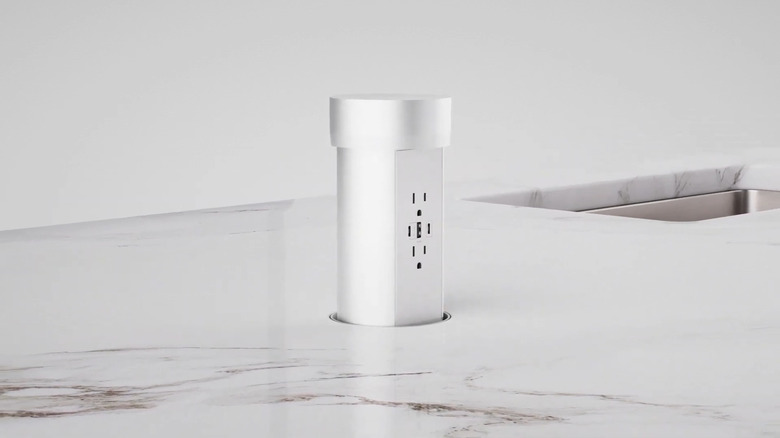Can You Install Popup Countertop Outlets Yourself Or Do You Need A Pro?
Pop-up countertop outlets are a great addition to a kitchen island where you'd like hidden outlets. And, with one caveat, installing them seems like one of the easier DIY projects you'll take on this month. But that one caveat is a doozy. Stand back, look at your lovely kitchen countertop, and remember the day you had them installed. Do you remember what you said to yourself that day? It probably wasn't, "I can't wait to drill some giant holes in this stuff that just cost me $170 per square foot." Chances are pretty good that it's a project you've never done before, involving a material you've probably never cut before. So, you naturally ask yourself if it's wise to take it on as a DIY project rather than bringing in a professional. And the answer is that you probably can do it, depending on your countertop material and electrical wiring. But it will probably be a little nerve-wracking.
Installation of pop-up outlets is usually pretty simple. For the common plug-in variety that connects to a receptacle under your counter (rather than being hard-wired), all that's typically required is cutting a large (about 4-inch) hole, dropping the pop-up in, tightening a locking flange under the counter, and plugging it in. Some models use the disc of countertop material you cut out to create a seamless look, which is a matter of setting some depth screws and gluing it in. Hard-wired models will require that some — maybe a lot — of wiring is done.
How to decide if this is a DIY project for you
With the right equipment, you certainly can cut the holes in most countertop materials for a pop-up outlet. In fact, cutting holes for faucets is a fairly common DIY project, and the process is identical. The gear you need will likely include a specialized hole saw that's impregnated with a diamond abrasive, as well as perhaps an impact driver or hammer drill. Dekton, quartzite, quartz, granite, ceramic tile, marble, and some lesser-known countertop materials all require a diamond abrasive core drill bit. Soapstone can be cut with a diamond hole saw or with a hole saw meant for cutting metal. Laminate countertops can be cut with a standard spade bit. Solid-surface countertops like Corian can be cut with the usual woodworking tools: a hole saw, Forstner bit, or spade bit. For seamless pop-ups like Point Pods, you'll need a very clean cut because the core will be used to top the outlet. While it can be accomplished with tools like diamond-impregnated hole saws, a professional waterjet cutting might be the better idea.
There's one other pro whose help you might need. If there's not already an outlet below your countertop or if you're doing a hard-wired installation, you will probably need a licensed electrician to do the work and pull a permit as well. Some jurisdictions will allow homeowners to do this work but might require an inspection of the result by an official or a licensed electrician.
